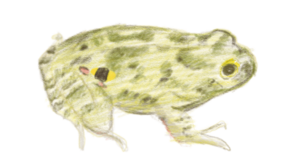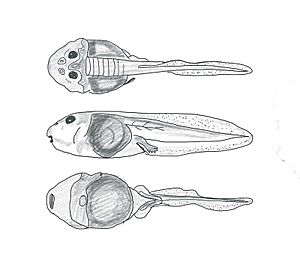Pleurodema cordobae facts for kids
Quick facts for kids Pleurodema cordobae |
|
|---|---|
| Conservation status | |
| Scientific classification | |
| Genus: |
Pleurodema
|
| Species: |
cordobae
|
The Pleurodema cordobae is a type of frog that belongs to the Leptodactylidae family. It is found only in a specific area, meaning it is endemic, to the Sierras de Córdoba mountains in Argentina. This frog lives in the same area as a very similar frog called Pleurodema kriegi.
P. cordobae has special features that make it different from other frogs in the Pleurodema group. For example, it is "octoploid," which means its cells have eight sets of chromosomes. Other frogs like P. kriegi and Pleurodema bibroni are "tetraploid," meaning they have four sets. P. cordobae lives in ponds that are sometimes dry and sometimes have water. Because this frog is only found in a few small places, like the Sierra Grande, scientists don't know much about how many of them there are.
Contents
Where P. cordobae Lives
The Pleurodema cordobae frog shares its home in the Sierras de Córdoba mountains with another frog found only there, the Pleurodema kriegi. The shape of the land and how the earth moved long ago helped create many unique plants and animals in this area. This happens when groups of animals become separated and change over time.
Both P. cordobae and P. kriegi live in a specific region. This area stretches from the Pampa de Achala and Sierra de Comechingones in the Córdoba province, down to the southern part of the Sierras de Córdoba.
Scientists have found P. cordobae in a few ponds. For example, they found them at Estancia Los Tabaquillos and two other ponds nearby. In Los Linderos, they found 13 frogs in two ponds. In Puesto Pereyra, Pampa de Achala, 11 frogs were found in two ponds. Another 16 P. cordobae frogs were found in Mal Paso, Pampa de Achala. Interestingly, the two ponds at Estancia Los Tabaquillos do not have the P. kriegi species.
Habitat and Daily Life
P. cordobae frogs usually live in ponds that dry up sometimes or have water for most of the year. These ponds are found in high grasslands. They have plants growing along their edges and are about 20 to 30 centimeters deep.
Male P. cordobae frogs start making sounds to attract mates from December to March, which is summer in Argentina. They call from about 9:00 PM until 4:00 AM. This frog species has been seen living alongside other frogs like Rhinella achalensis, Rhinella arenarum, Odontophrynus achalensis, and Hypsiboas cordobae.
In 2010, scientists saw that the frogs' egg masses were stuck to plants. These plants were most common along the edges of the ponds. This might explain why smaller ponds had more nests, as they have more edge compared to their total water area.
Appearance of P. cordobae
Adult Frogs
Adult Pleurodema cordobae frogs are quite small. They have short snouts. Their backs are yellow with green spots, and their bellies are whitish with a few dark dots. Their palms and the bottoms of their feet are dark. They have two light-colored bumps on their palms and two on the bottoms of their feet. Their fingers and toes are not webbed.
Male P. cordobae frogs have a single, dark vocal sac under their chin, which they use to make calls. They have a round eardrum that is mostly hidden. This eardrum is about half the size of their eye. These frogs do not have vomerine teeth (small teeth on the roof of the mouth).
Their real eyes have golden centers with black lines. They also have special yellow glands on their lower back, called lumbar glands. These glands have a black spot in the middle, making them look like extra eyes. This is why frogs in the Pleurodema group are often called "four-eyed frogs." These lumbar glands are about one and a half times the size of their eyes. This feature helps tell them apart from other Pleurodema species like Pleurodema tucumanum, Pleurodema nebulosum, Pleurodema guayapae, Pleurodema marmoratum, and Pleurodema diplolister. There is also a bright red-orange spot on the frog's groin area, around these lumbar glands.
From the outside, P. cordobae looks very much like P. kriegi. It's impossible to tell them apart just by looking at them. However, if you look inside, the red blood cells of P. cordobae are much larger than those of P. kriegi. Scientists can also use genetic tests to tell the two species apart, because P. cordobae is octoploid (has eight sets of chromosomes) and P. kriegi is not.
Tadpoles
Pleurodema cordobae tadpoles are usually about 39 millimeters long in total. Their body length is about 40% of their total length. The tadpoles have light brown heads and snouts. They have more dark color around their nostrils and less around their eyes. Their belly area is a shiny copper color. The main body area is much darker and has a greenish shine.
The tadpoles' mouth is at the front and bottom of their head. It has a single or double row of small bumps around the edge. There are small, cone-shaped bumps, but no bumps underneath the main row. The top part of the tadpole's mouth is wide and arch-shaped, while the bottom part is V-shaped. Both parts of the mouth are hard and tough. The breathing tube of the P. cordobae tadpole is single, short, on the left side, and points towards the back and top.
Reproduction and Life Cycle
Pleurodema cordobae frogs have similar ways of reproducing to P. kriegi and P. bibroni. The male frogs use a special call to attract females for mating. One way P. cordobae is different is its "pulse rate" in its call, which is higher than the other species. This difference helps them find the right mate.
As mentioned before, P. cordobae is also unique because it is "octoploid," meaning its cells have eight sets of chromosomes. The other two species are "tetraploid," with four sets. Male frogs call out to mates from December to March. They often call while floating at the edge of a pond.
Conservation Status
The P. cordobae frog is common within its small home area. However, it is mostly seen only during the time it breeds. There are no big threats to this frog right now. Its home range includes the Pampa de Achala Provincial Water Reserve. It might also extend into the Quebrada del Condorito National Park.
See also
 In Spanish: Pleurodema cordobae para niños
In Spanish: Pleurodema cordobae para niños




